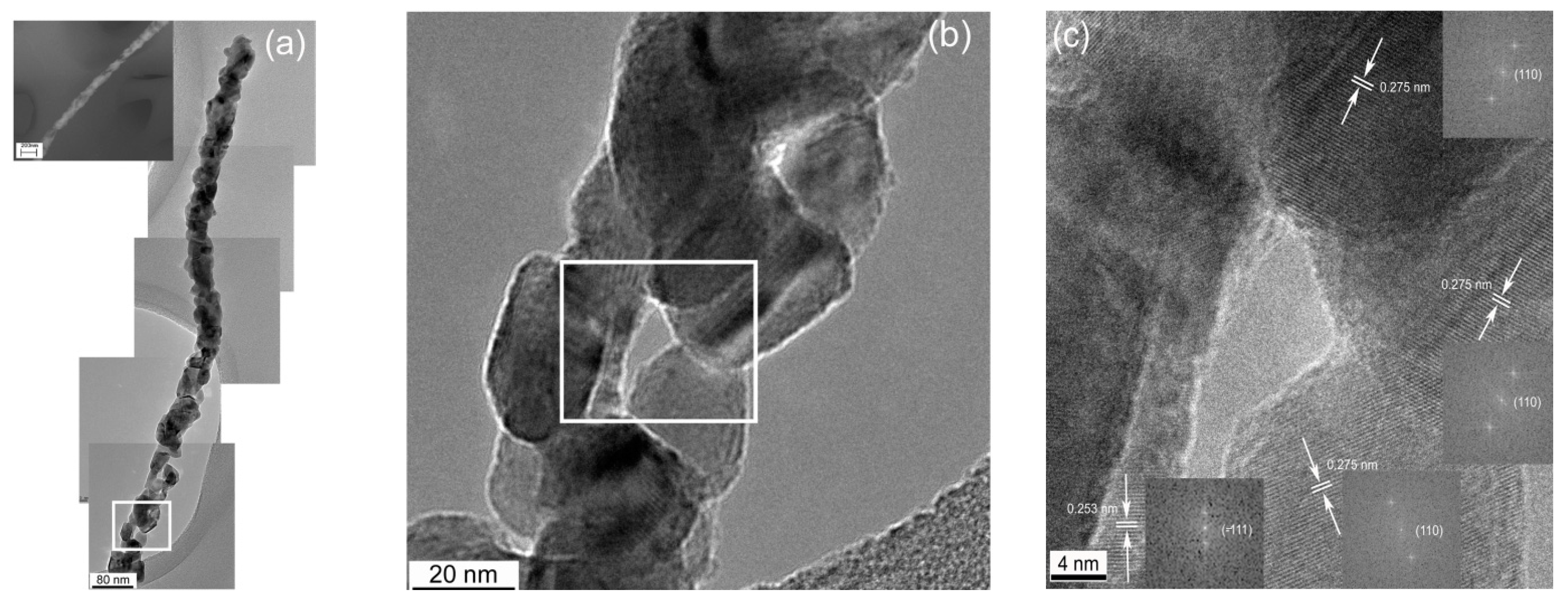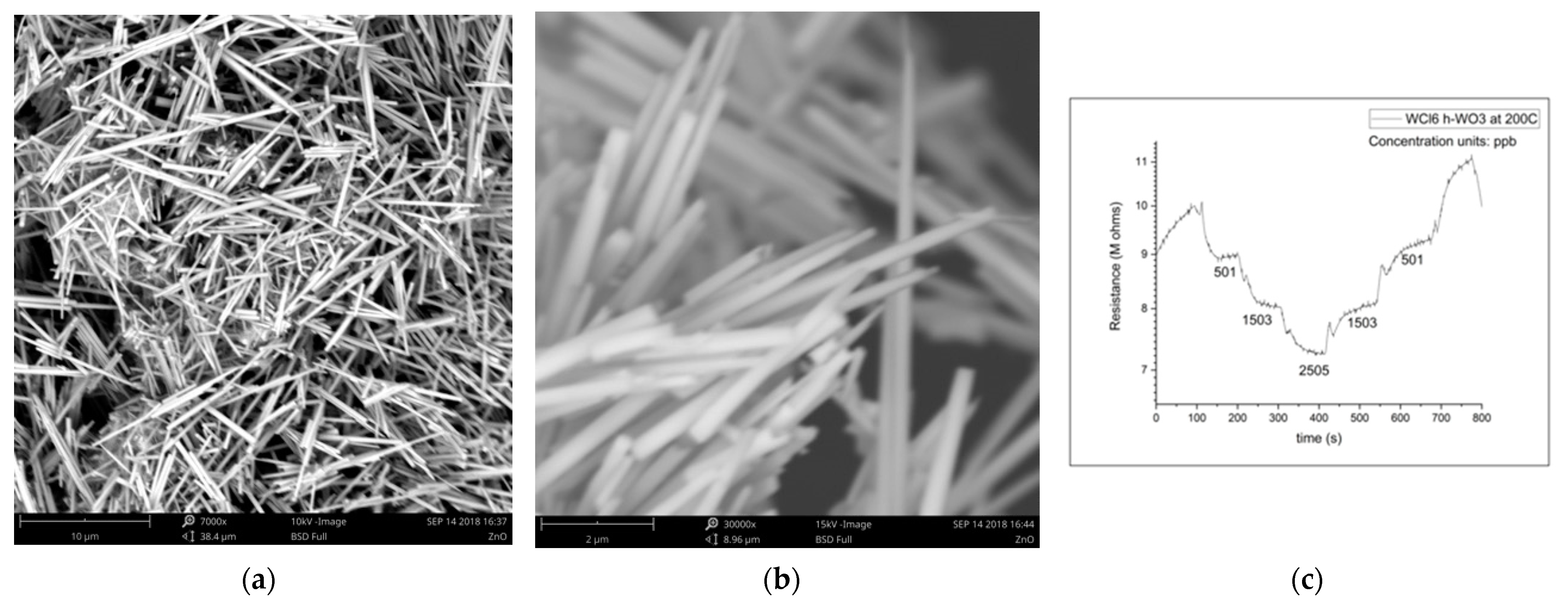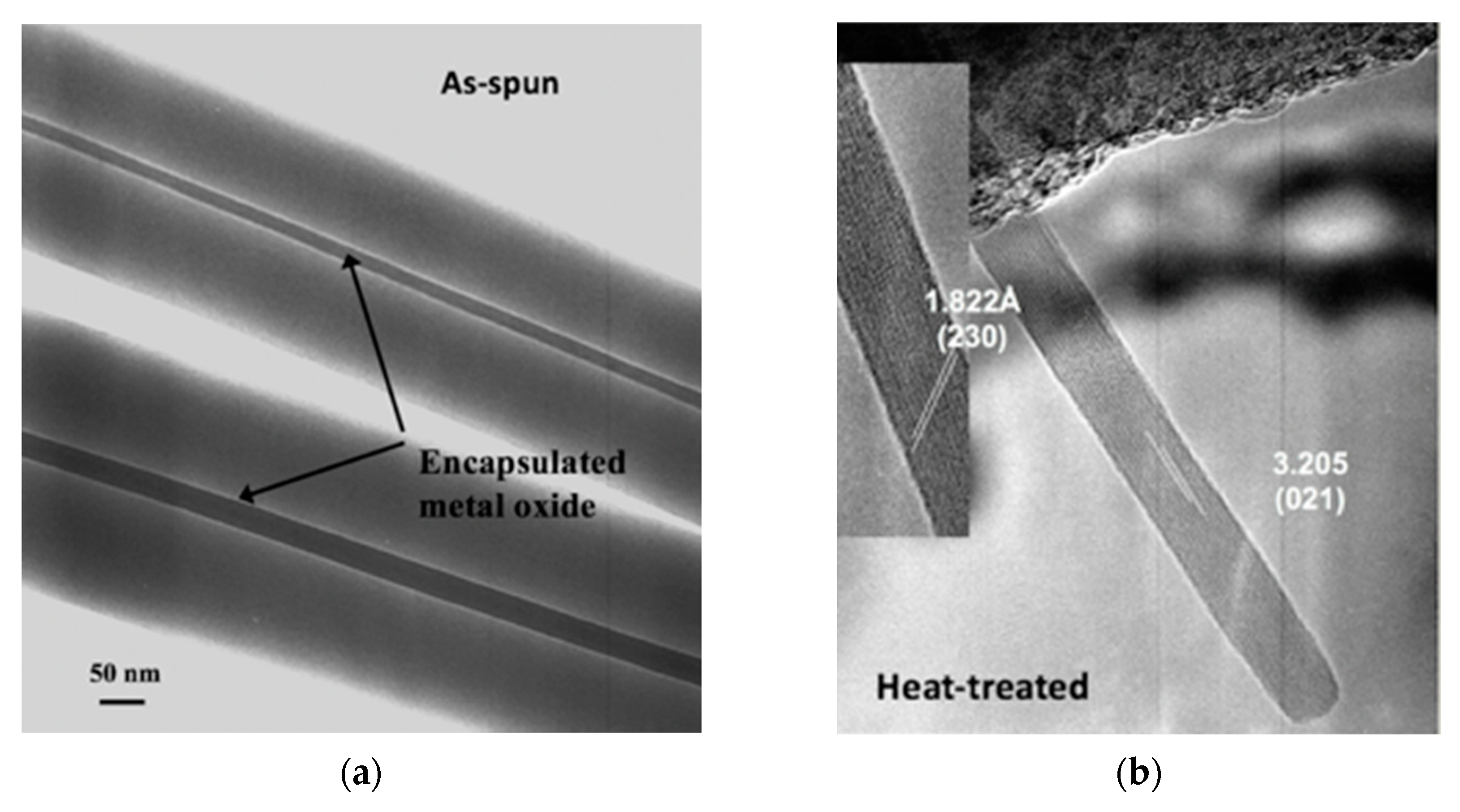Future Trends in Semiconducting Gas-Selective Sensing Probes for Skin Diagnostics
Abstract
:1. Introduction
2. The State-of-the-Art Biomarkers
3. Ceramic Semiconducting Sensing Probes
3.1. Nanowires of α-MoO3 for Selective Ammonia Sensing
3.2. CuO Nanowires for H2S Detection
3.3. Nanowires of Hexagonal WO3 for Selective Isoprene Detection
3.4. Ferroelectric ε-WO3 for Acetone Sensing
4. Conclusions
Author Contributions
Funding
Institutional Review Board Statement
Informed Consent Statement
Data Availability Statement
Acknowledgments
Conflicts of Interest
References
- Phillips, M. Detection of volatile organic compounds in breath. In Disease Markers in Exhaled Breath; Marczin, N., Kharitonov, S.A., Yacoub, M.H., Barnes, P.J., Eds.; Marcel Decker: New York, NY, USA, 2002; pp. 219–231. [Google Scholar]
- Gouma, P. Interview: Revolutionizing personalized medicine with nanosensor technology. J. Pers. Med. 2011, 8, 15–16. [Google Scholar] [CrossRef]
- Karl, T.; Prazeller, P.; Mayr, D.; Jordan, A.; Rieder, J.; Fall, R.; Lindinger, W. Human breath isoprene and its relation to blood cholesterol levels: New measurements. J. Appl. Physiol. 2001, 91, 762–770. [Google Scholar] [CrossRef] [PubMed] [Green Version]
- Risby, T.H. Critical issues for breath analysis. J. Breath Res. 2008, 2, 03030. [Google Scholar] [CrossRef]
- Manolis, A. The diagnostic potential of breath analysis. Clin. Chem. 1983, 29, 5–15. [Google Scholar] [CrossRef] [PubMed]
- Roine, A.; Saviauk, T.; Kumpulainen, P.; Karjalainen, M.; Tuokko, A.; Aittoniemi, J.; Vuento, R.; Lekkala, J.; Lehtimäki, T.; Tammela, T.; et al. Rapid and Accurate Detection of Urinary Pathogens by Mobile IMS-Based Electronic Nose: A Proof-of-Principle Study. PLoS ONE 2014, 9, e114279. [Google Scholar] [CrossRef] [PubMed] [Green Version]
- Pavlou, A.K.; Magan, N.; McNulty, C.; Jones, J.; Sharp, D.; Brown, J.; Turner, A.P.F. Use of an electronic nose system for diagnoses of urinary tract infections. Biosens. Bioelectron. 2002, 17, 893–899. [Google Scholar] [CrossRef]
- D’Amico, A.; Pennazza, G.; Santonico, M.; Martinelli, E.; Roscioni, C.; Galluccio, G.; Paolesse, R.; Di Natale, C. An investigation on electronic nose diagnosis of lung cancer. Lung Cancer 2010, 68, 170–176. [Google Scholar] [CrossRef] [PubMed]
- Roine, A.; Veskimäe, E.; Tuokko, A.; Kumpulainen, P.; Koskimäki, J.; Keinänen, T.A.; Häkkinen, M.R.; Vepsäläinen, J.; Paavonen, T.; Lekkala, J.; et al. Detection of Prostate Cancer by an Electronic Nose: A Proof of Principle Study. J. Urol. 2014, 192, 230–235. [Google Scholar] [CrossRef] [PubMed]
- Turner, C.; Parekh, B.; Walton, C.; Spanl, P.; Smith, D.; Evans, M. An exploratory comparative study of volatile compounds in exhaled breath and emitted by skin using selected ion flow tube mass spectrometry. Rapid Commun. Mass Spectrom. 2008, 22, 526–532. [Google Scholar] [CrossRef] [PubMed]
- Tsuda, T.; Ohkuwa, T.; Itoh, H. Findings of skin gases and their possibilities in healthcare monitoring. In Gas Biology Research in Clinical Practice; Yoshikawa, T., Naito, Y., Eds.; Karger: Basel, Switzerland, 2011; pp. 125–132. [Google Scholar] [CrossRef]
- Dweik, R.A.; Boggs, P.B.; Erzurum, S.C.; Irvin, C.G.; Leigh, M.W.; Lundberg, J.O.; Olin, A.-C.; Plummer, A.L.; Taylor, D.R. An official ATS clinical practice guideline: Interpretation of exhaled nitric oxide levels (FENO) for clinical applications. Am. J. Respir. Crit. Care Med. 2011, 184, 602–615. [Google Scholar] [CrossRef] [Green Version]
- Alessi, S.M.; Barnett, N.P.; Perry, N.M. Experiences with SCRAMx alcohol monitoring technology in 100 alcohol treatment outpatients. Drug Alcohol. Depend. 2017, 178, 417–424. [Google Scholar] [CrossRef]
- Yamada, Y.; Hiyama, S.; Toyooka, T.; Onoe, H.; Takeuchi, S. Skin-emitted acetone towards self-monitoring of detection of fat metabolisms. In Proceedings of the 17th International Conference on Miniaturized Systems for Chemistry and Life Sciences (MicroTAS 2013), Freiburg, Germany, 27–31 October 2013; Chemical and Biological Microsystems Society: San Diego, CA, USA, 2013; Volume 3, pp. 1842–1844. [Google Scholar]
- Mitchell, G.; Kassovska-Bratinova, S.; Boukaftane, Y.; Robert, M.; Wang, S.; Ashmarina, L.; Lambert, M.; Lapierre, P.; Potier, E. Medical aspects of ketone body metabolism. Clin. Investig. Med. Med. Clin. Exp. 1995, 18, 193–216. [Google Scholar]
- Mori, K.; Funada, T.; Kikuchi, M.; Ohkuwa, T.; Itoh, H.; Yamazaki, Y.; Tsuda, T. Influence of dynamic hand-grip exercise on acetone in gas emanating from human skin. Redox Rep. 2008, 13, 139–142. [Google Scholar] [CrossRef] [PubMed]
- Nakagawa, M.; Kawabata, S.; Nishiyama, K.; Utsonomiya, K.; Yamamoto, I.; Wada, T.; Yamashita, Y.; Yamashita, N. Analytical detection system of mixed odor vapors using chemiluminescence-based gas sensor. Sens. Actuators B Chem. 1996, 34, 334–338. [Google Scholar] [CrossRef]
- Zhu, Y.; Shi, J.; Zhang, Z.; Zhang, A.C.; Zhang, X. Development of a gas sensor utilizing chemiluminescence on nanosized titanium dioxide. Anal. Chem. 2002, 74, 120–124. [Google Scholar] [CrossRef]
- Yamada, Y.; Hiyama, S.; Toyooka, T.; Takeuchi, S.; Itabashi, K.; Okubo, T.; Tabata, H. Ultratrace Measurement of Acetone from Skin Using Zeolite: Toward Development of a Wearable Monitor of Fat Metabolism. Anal. Chem. 2015, 87, 7588–7594. [Google Scholar] [CrossRef]
- Taguchi, N. Gas Detecting Device. U.S. Patent US3695848A, 4 July 1970. [Google Scholar]
- Gouma, P.; Kalyanasundaram, K.; Bishop, A. Electrospun Single Crystal MoO3 Nanowires for Bio-Chem sensing probes. J. Mater. Res. Nanowires Nanotub. Spec. Issue 2006, 21, 2904–2910. [Google Scholar]
- Dukiwicz, A.C.; Lacy, B.E.; Levine, G.M. Small intestinal bacterial overgrowth: A comprehensive review. Gastroenterol. Hepatol. 2007, 3, 112. [Google Scholar]
- Lee, H.-R.; Pimentel, M. Bacteria and irritable bowel syndrome: The evidence for small intestinal bacterial overgrowth. Curr. Gastroenterol. Rep. 2006, 8, 305–311. [Google Scholar] [CrossRef]
- Simren, M.; Stotzer, P.O. Use and abuse of hydrogen breath tests. Gut 2006, 55, 297–303. [Google Scholar] [CrossRef]
- Eisenmann, A.; Amann, A.; Said, M.; Datta, B.; Ledochowski, M. Implementation and interpretation of hydrogen breath tests. J. Breath Res. 2008, 2, 046002. [Google Scholar] [CrossRef]
- Ghoshal, U.C. How to interpret hydrogen breath tests. J. Neurogastroenterol. Motil. 2011, 17, 312. [Google Scholar] [CrossRef] [Green Version]
- Banik, G.D.; De, A.; Som, S.; Jana, S.; Daschakraborty, S.B.; Chaudhuri, S.; Pradhan, M. Hydrogen sulfide in exhaled breath: A potential biomarker for small intestinal bacterial overgrowth in IBS. J. Breath Res. 2016, 10, 026010. [Google Scholar] [CrossRef] [PubMed]
- Chen, J.; Wang, K.; Hartman, L.; Zhou, W. H2S detection by vertically aligned CuO nanowire array sensors. J. Phys. Chem. A 2008, 112, 16017–16021. [Google Scholar] [CrossRef]
- Gouma, P.I.; Mikaeili, F.; Lee, J.; Karimi, Y.; Stanacevic, M. Sensing device for breath biomarker detection. In Proceedings of the 2019 IEEE International Symposium on Olfaction and Electronic Nose (ISOEN), Fukuoka, Japan, 26–29 May 2019; pp. 1–3. [Google Scholar]
- Gouma, P.I.; Lee, J. Tailored 3D CuO Nanogrid Formation. J. Nanomater. 2011, 2011. [Google Scholar] [CrossRef] [Green Version]
- Yu, B.; Gouma, P. MS&T Presentation; The Ohio State University: Columbus, OH, USA, 2018. [Google Scholar]
- Wang, L.; Kalyanasundaram, K.; Stanacevic, M.; Gouma, P. Nanosensor Device for Breath Acetone Detection. Sens. Lett. 2010, 8, 1–4. [Google Scholar] [CrossRef]
- Wang, L. Tailored Synthesis and Characterization of Selective Metabolite-Detecting Nanoprobes for Handheld Breath Analysis; SUNY Stony Brook: Stony Brook, NY, USA, 2008. [Google Scholar]
- Wang, L.; Gouma, P. Selective Microstructure Synthesis and Sensing Dependencies: A WO3 study. In Metal Oxide Nanomaterials for Chemical Sensors; Carpenter, M.A., Mathur, S., Kolmakov, A., Eds.; Springer: New York, NY, USA, 2013. [Google Scholar]
- Gouma, P. Nanoceramic Sensors for Medical Applications. Am. Ceram. Soc. Bull. 2012, 91, 26–32. [Google Scholar]
- Wang, L.; Teleki, A.; Pratsinis, S.E.; Gouma, P.I. Ferroelectric WO3 Nanoparticles for Acetone Selective Detection. Chem. Mater. 2008, 20, 4794–4796. [Google Scholar] [CrossRef]



| Analyte | Dipole Moment (D) | Sensitivity at 0.2 ppm | Sensitivity at 0.5 ppm | Sensitivity at 1 ppm |
|---|---|---|---|---|
| Acetone | 2.88 | 1.55 | 2.05 | 2.90 |
| Ethanol | 1.69 | 1.08 | 1.15 | 1.32 |
| Methanol | 1.70 | 1.03 | 1.10 | 1.23 |
| NO | 0.159 | 1.00 | 1.05 | 1.09 |
| NO2 | 0.316 | 1.00 | 1.04 | 1.07 |
| NH3 | 1.417 | 1.02 | 1.03 | 1.05 |
| CO | 0.112 | 1.00 | 1.00 | 1.00 |
Publisher’s Note: MDPI stays neutral with regard to jurisdictional claims in published maps and institutional affiliations. |
© 2021 by the authors. Licensee MDPI, Basel, Switzerland. This article is an open access article distributed under the terms and conditions of the Creative Commons Attribution (CC BY) license (https://creativecommons.org/licenses/by/4.0/).
Share and Cite
Annerino, A.; Gouma, P.-I. Future Trends in Semiconducting Gas-Selective Sensing Probes for Skin Diagnostics. Sensors 2021, 21, 7554. https://doi.org/10.3390/s21227554
Annerino A, Gouma P-I. Future Trends in Semiconducting Gas-Selective Sensing Probes for Skin Diagnostics. Sensors. 2021; 21(22):7554. https://doi.org/10.3390/s21227554
Chicago/Turabian StyleAnnerino, Anthony, and Pelagia-Irene (Perena) Gouma. 2021. "Future Trends in Semiconducting Gas-Selective Sensing Probes for Skin Diagnostics" Sensors 21, no. 22: 7554. https://doi.org/10.3390/s21227554
APA StyleAnnerino, A., & Gouma, P.-I. (2021). Future Trends in Semiconducting Gas-Selective Sensing Probes for Skin Diagnostics. Sensors, 21(22), 7554. https://doi.org/10.3390/s21227554







